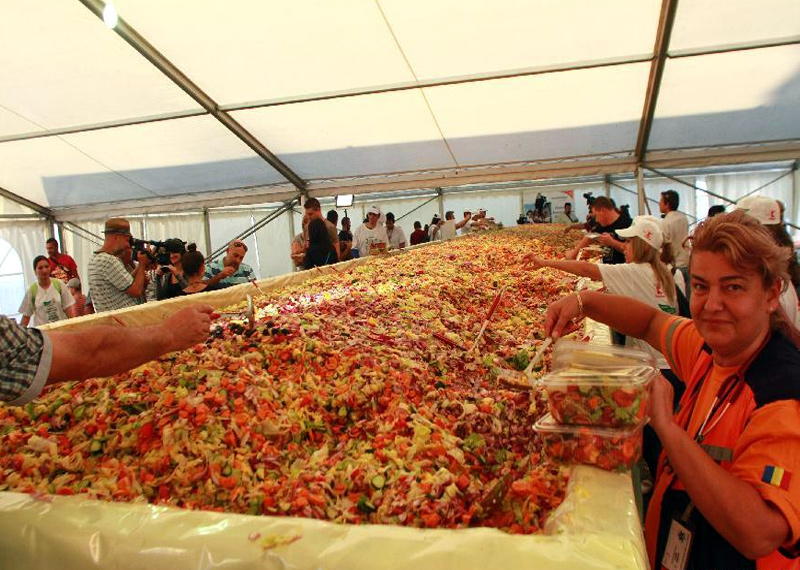- Egypt :

Egyptians spend around $78 per week on an average. Egyptian cuisine involves large quantities of legumes and vegetables and this is due to Egypt’s rich Nile Valley and Delta producing large quantities of excellent crops. Egyptian cuisine is based on foods that grow out of the ground, and they consume only small quantities of meat due to the fact that throughout Egypt’s history, meat has always been very expensive to purchase. - Ecuador, Tingo:

A family from Ecuador only spends around $32 per week on an average on their groceries. Ecuadorian cuisine varies with altitude and agricultural conditions. Pork, chicken, beef, and guinea pig are popular in the mountainous regions, and these are served with rice, corn, and potatoes. A wide variety of fresh fruit is eaten, including Granadilla, passion fruit, naranjilla, several types of bananas, villa, taxi, and tree tomato while people living along the coast of the country often eat fish, beans, and un-ripened bananas. In the rainforest, a dietary staple is a starchy root which is then peeled and boiled, fried, or used in a variety of other dishes. - United States:

A family from the United States spends around $342 per week on an averageon groceries for their family of four. Fast foods like MsDonalds, Pizza, fried chicken, hot dog, nachos, burger king, cereals, eggs, toast, pancakes, coffee, juice, bacon, ice-creams, fruits, etc., are a huge part of an American cuisine. - China:

A family from China spends around $65 per week on an average on their groceries! The Chinese cooking is quite well known for its hot and spicy flavors and also for its sweet and sour style. Common Chinese ingredients like shallots, ginger, garlic and soy sauce with either rice or noodles. - Mexico:

A family from Mexico spends around $189 per week on an average on their groceries. The basic staples of Mexican food include native corn, beans, chili peppers, tomatoes, squashes, avocados, cocoa and vanilla.Mexican cuisine also uses a lot of beef, pork, chicken, goat and sheep meat, as well as cheese and herbs and spices and tropical fruits such as prickly pear, sapote, guava, mangoes, bananas, pineapple and custard apple are extremely popular. - Mali, Kouakourou

A family from Mali spends just $30 per week on an average on groceries. Although Malian dishes vary from region – rice, millet, sorghum and fonio all provide staple ingredients. Meals are served with sauces of fish, meat or vegetables, and grains are often used to make porridge. A healthy juice made from hibiscus, ginger or the fruit of the baobab tree is a Malian specialty! - Kuwait:

A family from Kuwait spends around $252 per week on an average. The national dish of Kuwait consists of mutton, chicken, or fish placed over or mixed into a large amount of rice. - Japan:

A family from Japan spends around $361 per week on an average on their groceries. The traditional food of Japan includes rice and miso soup. Side dishes often consist of pickled vegetables, fish, and vegetables cooked in broth with the fish often grilled or served raw as sashimi or in sushi.Japanese food is traditionally flavored using a combination of dashes, soy sauce, sake and mirin, vinegar, sugar, and salt. - Italy:

A family from Italy, and they spend around $295 per week on an average on their groceries.Traditional Central Italian cuisine commonly uses ingredients such as tomatoes, meat, fish, and pecorino cheese, cheese, wine and espresso coffee are all a part of Italian cuisine; pasta, penne, macaroni, spaghetti, linguine, Fusilli, lasagne, ravioli and tortellini. Basil, nuts and olive oil are also popular ingredients used in Italian cooking and a wide variety of breads. - India:

A family from India spends around $45 per week on an average on their groceries.Staple foods of Indian cuisine include pearl millet, rice, whole-wheat flour, and a variety of lentils, spices, like chili pepper, black mustard seed, cardamom, cumin, turmeric, ginger, coriander and garlic. Desserts and sweeter dishes are seasoned with cardamom, saffron, nutmeg, and rose petal essences. Indians prefer Tea or coffee and their breads- Roti/Parathas/Kulcha and various types of Indian breads are made almost on a daily basis. - Germany:

A family from Germany spends a whopping $568 per week on an average on Pork, beef, and poultry are the main varieties of meat consumed in Germany,and chicken, duck, goose, and turkey are also widely consumed across the country. Vegetables are commonly used in stews or vegetable soups and are also served as side dishes. Carrots, turnips, spinach, peas, beans, broccoli, potatoes, cabbage and onions are very common additions to meals. Germans also love to eat bread rolls with their meals, and these are often cut in half and spread with condiments such as cheese, honey, jam, Nutella, butter, margarine, or even filled with cold meats or fish. - Australia:

A family from Australia spends around $428 per week on an average on groceries. Potatoes, dairy products, coffee, pies, doughnuts, hamburgers, steak and vegetables, roast chicken and vegetables, spaghetti bolognaise and beef casserole, BBQ, steak from the common foods of an Australian cuisines. - Canada:

A family from Canada spends around $392 per week on groceries on an average. Coffee, ribs and bacon, raspberries, waffles, muffins and flax, stew, quinoa from the major foods of a Canadian household.
By: Archa Dave

























